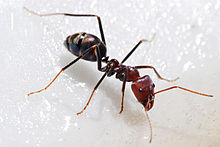Iridomyrmex
This article includes a list of references, related reading, or external links, but its sources remain unclear because it lacks inline citations. (June 2011) |
| Iridomyrmex | |
|---|---|

| |
| Meat ant (I. purpureus) | |
| Scientific classification | |
| Kingdom: | |
| Phylum: | |
| Class: | |
| Order: | |
| Family: | |
| Subfamily: | |
| Genus: | Iridomyrmex Mayr, 1862
|
| Species | |
|
Iridomyrmex purpureus | |
| Diversity | |
| c. 60 species | |
Iridomyrmex is a genus of ants that belongs to the subfamily Dolichoderinae. There are 79 species and subspecies that belong to this genus and they range from India to China to Australia and New Caledonia.
Description
Unlike other genera in Dolichoderinae, Iridomyrmex ants have the front margin of the clypeus above the mandibles highly modified with convex areas towards the sides and a central projection, which varies from strongly to weakly developed. The compound eyes are relatively high on the head and away from the mandibles.
Behaviour

Iridomyrmex ants are generally aggressive to other ants. They form large nests (from several hundred to over 300,000 workers), which limits the number of competing nests that can be formed in a given area. Often, the only neighbouring ant species that can co-exist are those that are of different size or those that forage for food at different times, thus limiting contact with the Iridomyrmex ants. They can be territorial even with ants of their own species but from different nests.
Nests may be above or below ground, with some species such as I. conifer alternating between the two. Meat ants (I. purpureus) are known to create "super-colonies" of many small nests that are connected together, reaching as large as 650 metres in length.
Feeding
Iridomyrmex ants are generally scavengers. Workers of some species will form "highways" to food sources, while workers of other species forage singly. Iridomyrmex are particularly attracted to seeds with elaiosomes. They will collect these seeds and remove the elaiosomes, discarding the seeds afterwards. The seedlings that sprout from these seeds benefit from the aggressiveness of the Iridomyrmex ants, giving them a better chance of survival.
Caterpillars of certain butterfly species have a symbiotic relationship with Iridomyrmex ants. They produce secretions that the ants will feed on. In extreme cases, the ants will carry the caterpillar back to their nests where they will protect it. These ants may also tend to aphids and coccids, collecting nectar when possible.
Predators
Some invertebrate species specialise in predation of Iridomyrmex ants. There are species of spiders that can detect the ants' chemical communications and selectively target injured members. Ground beetles also have been known to create burrows near ant nests and prey on passing workers.
The Thorny Devil is also a major Iridomyrmex predator.
Species

- Iridomyrmex agilis Forel, 1907
- Iridomyrmex albitarsus Wheeler, 1927
- Iridomyrmex anceps (Roger, 1863)
- Iridomyrmex anderseni Shattuck, 1993
- Iridomyrmex angusticeps Forel, 1901
- Iridomyrmex anteroinclinus Shattuck, 1993
- Iridomyrmex argutus Shattuck, 1993
- Iridomyrmex bicknelli Emery, 1898
- Iridomyrmex bigi Shattuck, 1993
- Iridomyrmex breviantennis Theobald, 1937
- Iridomyrmex butteli (Forel, 1913)
- Iridomyrmex calvus Emery, 1914
- Iridomyrmex cappoinclinus Shattuck, 1993
- Iridomyrmex cephaloinclinus Shattuck, 1993
- Iridomyrmex chasei Forel, 1902
- Iridomyrmex conifer Forel, 1902
- Iridomyrmex cyaneus Wheeler, 1915
- Iridomyrmex discors Forel, 1902
- Iridomyrmex dromus Clark, 1938
- Iridomyrmex emeryi Crawley, 1918
- Iridomyrmex exsanguis Forel, 1907
- Iridomyrmex extensus Emery, 1887
- Iridomyrmex florissantius Carpenter, 1930
- Iridomyrmex galbanus Shattuck, 1993
- Iridomyrmex geinitzi (Mayr, 1868)
- Iridomyrmex gracilis (Lowne, 1865)
- Iridomyrmex greensladei Shattuck, 1993
- Iridomyrmex hartmeyeri Forel, 1907
- Iridomyrmex haueri (Mayr, 1867)
- Iridomyrmex hesperus Shattuck, 1993
- Iridomyrmex innocens Forel, 1907
- Iridomyrmex krakatauae Wheeler, 1924
- Iridomyrmex latifrons Karavaiev, 1933
- Iridomyrmex lividus Shattuck, 1993
- Iridomyrmex mapesi Wilson, 1985
- Iridomyrmex mattiroloi Emery, 1898
- Iridomyrmex meinerti Forel, 1901
- Iridomyrmex mimulus Shattuck, 1993
- Iridomyrmex mjobergi Forel, 1915
- Iridomyrmex notialis Shattuck, 1993
- Iridomyrmex oblongiceps Wheeler, 1915
- Iridomyrmex obscurans Carpenter, 1930
- Iridomyrmex obscurus Crawley, 1921
- Iridomyrmex obsidianus Emery, 1914
- Iridomyrmex occiduus Shattuck, 1993
- Iridomyrmex prismatis Shattuck, 1993
- Iridomyrmex purpureus (Smith, 1858)
- Iridomyrmex reburrus Shattuck, 1993
- Iridomyrmex rufoinclinus Shattuck, 1993
- Iridomyrmex rufoniger (Lowne, 1865)
- Iridomyrmex sanguineus Forel, 1910
- Iridomyrmex spadius Shattuck, 1993
- Iridomyrmex spodipilus Shattuck, 1993
- Iridomyrmex variscapus Shattuck, 1993
- Iridomyrmex vicinus Clark, 1934
- Iridomyrmex viridiaeneus Viehmeyer, 1914
- Iridomyrmex viridigaster Clark, 1941
- Iridomyrmex wingi Donisthorpe, 1949
See also
- Iridomyrmecin, a defensive chemical produced by Iridomyrmex
References
- "Iridomyrmex Mayr, 1862". Ants Down Under. CSIRO Entomology. Retrieved June 26, 2011.
- "Meat Ant, Gravel Ant Fact File". Australian Museum. Archived from the original on 2007-03-02. Retrieved 2007-04-10.
- "Iridomyrmex Mayr, 1862". Integrated Taxonomic Information System. Retrieved June 26, 2011.
